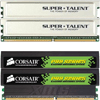- Qualcomm Launches Snapdragon 4 Gen 2 Mobile Platform
- AMD Launches Ryzen PRO 7000 Series Mobile & Desktop Platform
- Intel Launches Sleek Single-Slot Arc Pro A60 Workstation Graphics Card
- NVIDIA Announces Latest Ada Lovelace Additions: GeForce RTX 4060 Ti & RTX 4060
- Maxon Redshift With AMD Radeon GPU Rendering Support Now Available
4GB Trials and Tribulations

Have you ever wondered what it would be like to move on up to 4GB of system ram? There may not be a need for that now, but it won’t take very long until it’s commonplace in enthusiast PC’s. I take 4GB worth of top end DDR1 and DDR2 memory, and relate my overclocking and performance reports to you.
Page 1 – Introduction
|
|
It wasn’t too long ago that having 1GB worth of total system memory was more than enough for anything you wanted to do. In fact, the majority of people still use 1GB or less, and are content. When a few games were released though, such as FEAR and Battlefield II, people started to see clear benefits of moving up to 2GB worth of ram in their system. Those two games specifically can stress all areas of your system, including GPU, CPU and of course your system memory.
This article is not a review of any 4GB kit, but rather an article explaining the pros and cons of moving up to 4GB. I have spent a lot of time overclocking both DDR1 and DDR2 4GB configurations, so you can expect in-depth performance reports later.
Generally speaking, the better the graphics and higher the resolution a game has, the harder it will be on your ram. I found this out last year when I was conducting tests with the FEAR demo. I found, that simply going from 1GB to 2GB released a lot of stress overall on the system, and gave me far better overall FPS. The same results were found about Battlefield II, but I never personally performed any such tests.
While many people are still using 1GB kits in their PC’s, 2GB’s are catching on at a very rapid pace. Speaking with one enthusiast memory manufacturer recently, they told me that they now sell *more* 2GB kits than anything else, so the transition is really in full effect. Of course, even with an Ultra High-End system consisting of a top end CPU and Quad-SLi doesn’t really need anything more than 2GB. There just isn’t a need for it, if you are focusing on one application at a time, such as a game.
There’s a certain mystique that some people have about having 4GB worth of ram in their computer. No doubt, there are indeed actual needs for this much memory, but most of these reasons usually have to do with multimedia production. Graphic designers, movie editors and even large Photoshop projects can hog all of your memory, and cry for more.
There are also countless myths, or misunderstanding when it comes to having 4GB in your computer. The first is the fact that the more memory you have in your computer, the slower it will be, in terms of bandwidth. In fact, this is both true and false, depending on your motherboard and CPU configuration. We’ll get into that shortly.
One of the most popular myths is that Windows cannot physically see anything above 3GB. Again, this is also true and false. Due to technical ‘limitations’ or ‘fixes’ in Windows XP Home and Professional, the Service Pack 2 removed the ability for Windows to see a full 4GB. If you have Windows XP Home/Professional with SP1 still installed, then you should have no issues in seeing the full 4GB. If you have a current install of Windows x64 Professional of Windows Server 2003, then you will see the full 4GB regardless, even with the latest service pack. If for some reason you still don’t see 4GB in Windows, it may be due to your motherboard or an option in your BIOS, such as PCI MMIO.
So the ultimate fact is, if you want to see a full 4GB in Windows, you will need either Windows x64 Professional or a standard copy of Home/Professional that has not been updated to SP2. You could also use Server 2003, if that’s the version you prefer.
|
|
Support our efforts! With ad revenue at an all-time low for written websites, we're relying more than ever on reader support to help us continue putting so much effort into this type of content. You can support us by becoming a Patron, or by using our Amazon shopping affiliate links listed through our articles. Thanks for your support!





